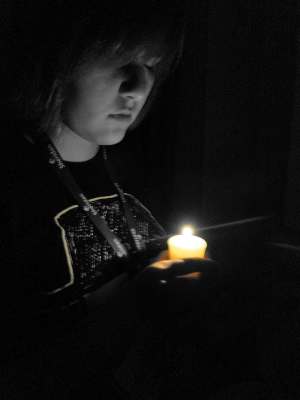
STORY BY MADDY SOMMERVILE
The air in the garden of Oakville’s St. Jude’s Anglican church hangs heavily. A single voice echoes through the cold air. A crowd of people stands around a gazebo, two speakers are set up and a microphone is open. In everyone’s hands, there is an electric candle and the orange light flickers to a beat of its own.
This is the Sisters in Spirit vigil in Oakville, one of many that took place across Canada on Oct. 4. This is the second year Oakville has gathered to remember murdered and missing aboriginal girls. The event featured speakers who appealed for justice amid a mood of palpable sorrow
Judy Rivard is an Oakville resident who is involved in Reclaim Our Democratic Canada . She was invited by another one of the attendees. “To acknowledge [the vigil] as a Canadian citizen,” she said “that it’s part of our history.”
Rivard says her family has been in Canada for about 400 years. She is part Mi’kmaq from the New Brunswick–Nova Scotia border.
“It can be eye opening,” she said. “Before I ever was invited to this last year, I was surfing the Internet and the particular issue was Robert Pickton’s pig farm. I remember looking at the photos [of the victims] that were much like mugshots. Some were probably literally mugshots.”
Pickton was convicted in 2007 for the murders of six women in British Columbia. Most of his victims were aboriginal women living on the streets.
“[These women] never had decent opportunities for education, for healthy family relationships,” said Rivard.
Pam Damoff, a town councillor of Oakville was also at the vigil.
“I think it’s just tragic that we as a nation don’t recognize the problems that are happening in our own backyard,” she said “We just ignore it we know more about the conditions in Africa than we do at home.”
Sherry Seavil is the Aboriginal Liaison Officer for the Halton Catholic School Board. Her mother is Cree and her dad was from England.
MORE RELATED TO THIS STORY:
- Giving a voice to aboriginal culture
- Ending your toxic love affair
- ‘Home Safe’: Laura Sky takes us through the lives of the homeless
“There’s a lot of history there with residential school, with being in foster care for numerous years myself,” she said. “My mom having mental health issues because of what she experienced in residential schools,”
While the evening was hosted to honour slain aboriginal women, participants were quick to reference the residential school system as a symbol of Canada’s troubled relationship with indigenous peoples. Residential schools were a tool used to assimilate native Canadians into European-Canadian society. In the 1880s, Ottawa established the sleep-away schools across Canada. Under the 1920 Indian Act it became mandatory for every aboriginal child to attend. It was illegal for parents to refuse to enroll their children.
Critics of the residential system charge that the schools were set up to “kill the Indian in the child.” The phrase has since become linked to the policy.
The schools continued to be run until the late 20th century. The last one was closed in 1996.
“Back in the ‘60s when she was suffering mental health issues, it was easy for social workers to come into our home and take us all away. So that’s how come we ended up in foster care,” said Seavil.“Not because our mom look after us but because my mom was looking for someone she could talk to so she could work out her problems but because she was a native lady they didn’t feel she had the ability to look after her children.”
Seavil spent seven years in childcare before her mother could get her children returned to her.
“A lot of it is embedded,” she said. “A lot of it is deep and a lot of it is colonial practice in this country when native people were thought to be less. [It’s] very serious issue and the education system [isn’t] teaching anything about it.”
“We need come to a point in our lives and a point soon in history where we know the truth and we also have to now start reconciliation and healing,” said Seavil. “This is not just a aboriginal issue, this is a Canadian issue.”
